I have a blog post to write. This blog post, to be exact.
And in the course of researching, outlining, writing, editing, and writing some more, I also have other hats to wear. Email marketing. Social media strategy. Blog promotion, blog design, and anything else that should happen across my plate.
I’m sure you wear a lot of hats, too.
How do you find time to put them all on?
One of the tasks that I’m currently optimizing is implementing a social media strategy at Buffer. Amid writing posts like these, I’m also curious to see how much time it takes to put a social media strategy in place.
Does juggling social media management and an armful of other tasks sound familiar to you? If so, I thought it might be helpful to detail what I’ve found so far and to show what’s involved in the way that we go about managing our social media strategy at Buffer.
The wheel of social media strategy
It’s interesting to note that a social media strategy and a social media plan intersect a lot.
You can think of it this way: A strategy is where you’re headed. A plan is how you’ll get there.
When I think about the time involved in implementing a social media strategy, I can’t help but include the essential parts of our plan, too. In fact, I think that strategy can be boiled down to a simple three-part idea:
Once you come up with the strategy, you’ll need to implement it, to measure it, and to think on it again.
Here’s how this process might look.
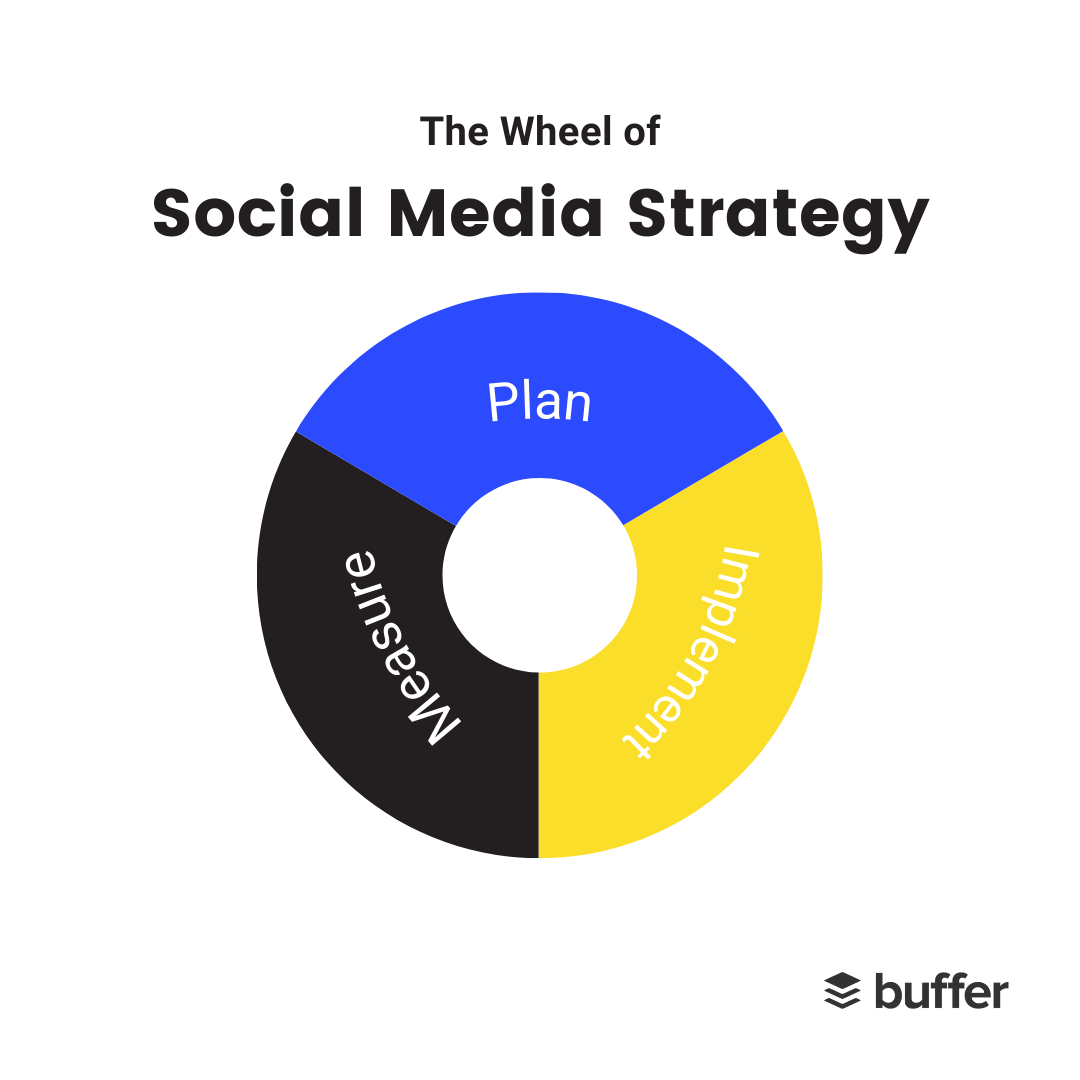
I’ve run across ideas like this before. For instance, Amy Porterfield’s social media strategy suggestion is to assess, implement, and monitor. Others call it Organize, Act, and Regroup.
Put another way:
- This is what we want to do
- This is how we’re going to do it
- This is how we did
Then, repeat.
That’s how I choose to view our social media strategy at Buffer. And now for the all-important follow-up question: How long does this process take?
The time it takes for a good social media strategy
I took my time-tracking seriously this week—so serious, in fact, that I used Harvest's time-tracking software to see exactly how long these things take. I wanted to see exactly how much time it takes to implement a solid social media strategy. Here’s what I found:
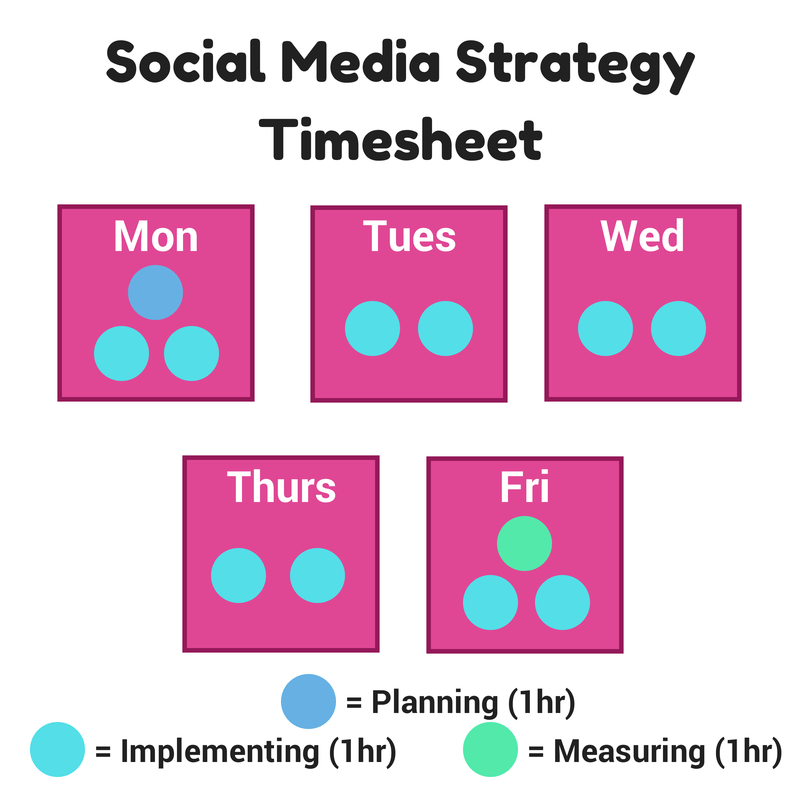
Essentially, the time breaks down like this:
Every Monday, revisit your strategy to make sure you’re on the right track and focusing on the right areas
Time: 1 hour
Monday through Friday, implement the strategy. Schedule, create, and post updates. Engage with the community.
Time: 2 hours
Every Friday, check your metrics. See how you’re doing on your goals, and identify areas for growth.
Time: 1 hour
Total time: 12 hours per week
Depending on the scope of your business, your time could be greater or smaller than this. You may have a team of dedicated social media staff who can give 40 hours per week or more. Or you may have a small footprint on social and not need as many hours. The above times are simply my experience; feel free to use them as a guide and benchmark for your own social strategy.
As far as what my time looks like specifically, here’s a taste of what’s involved at each step of the process: planning, implementing, and measuring.
1. Planning a social media strategy
A good social media strategy begins with a good think.
What do you want social to do for you or your brand? Sales? Loyalty? Awareness?
These are the three main areas that Jay Baer identifies as potential focus points of a social media strategy. As Baer puts it: "What’s the point of your social media marketing? Pick one of the above, and focus your efforts on that single objective."
The best social media strategies are those that focus (at least initially) on a more narrow rationale for social.
In thinking about this question of “What’s the point?” we’ve found that the answer may sometimes change as your marketing goals ebb and flow. I’d encourage you to revisit this question often. Don’t be afraid to shift gears and aim for a new objective.
For instance, you may find that it’s best early on to focus on awareness, especially if your business is fresh out of the box. Once you’ve built sufficient awareness, it might make sense to transition your focus to loyalty or sales. Your strategies can grow up as your business grows up.
Once you’ve defined your social focus, you can have a clear picture of success metrics to track. Amy Porterfield has a great way of breaking this down according to the three main social media strategies:
If you choose sales, you’ll want to track click rates, social e-commerce sales, and conversion rates.
If you choose loyalty, you’ll track engagement, sentiment, and influence.
If you choose awareness, you’ll track growth, engagement, shareability, likes, and subscribers.
One final piece of the puzzle – many social media strategists would advise beginning with this step – is listening to your audience. Listening will reveal several key factors like which social networks you should be on, how your audience uses social media, and what are their pain points.
These basic factors will be hugely helpful to discover as they’ll help set your focus moving forward. For instance, I’m often guilty of assuming that all social networks are generally the same when in fact, they are entirely unique and individual and deserving of their own specific messages and plans. The donut analogy is a fun reminder that each social media site comes at content differently.
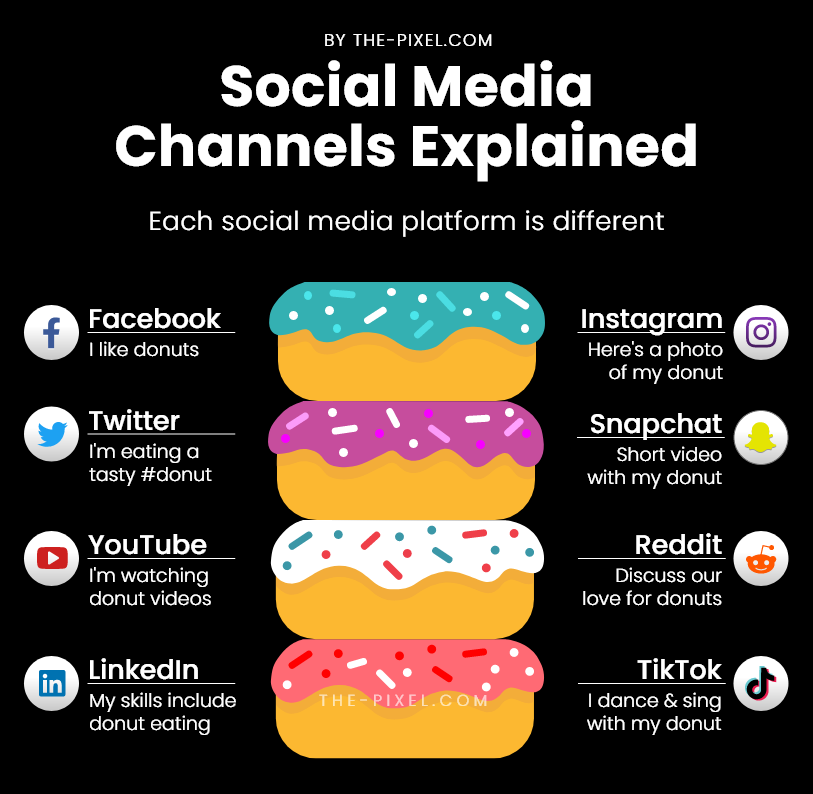
How can you go about listening to your audience?
You can begin by asking. Surveys are great tools for gathering insight into your customers and fans. If you’ve yet to implement your social strategy, you can send out a survey to your email list. If you’re already on social, you can ask questions of fans or link to surveys from your updates.
Beyond surveys, you can listen to your audience by tracking mentions of your brand, discovering the communities and groups based on your niche, and watching your key social metrics to see how they grow. For instance, if you find yourself banging your head against a wall to get new followers, it could be that your target demographic doesn’t hang out on that network.
Once you’ve listened to your audience, chosen a focused goal, and identified your success metrics, it’s time to move on to the next step: Implementation.
2. Implementing a social media strategy
I like to think of implementation as having two prongs: Creation and Community.
When you think about it, what kind of input will you be having on social media each day? You’ll be publishing new updates and responding to others – and sometimes, the two might even overlap. Both prongs should fit with the strategy you’ve chosen.
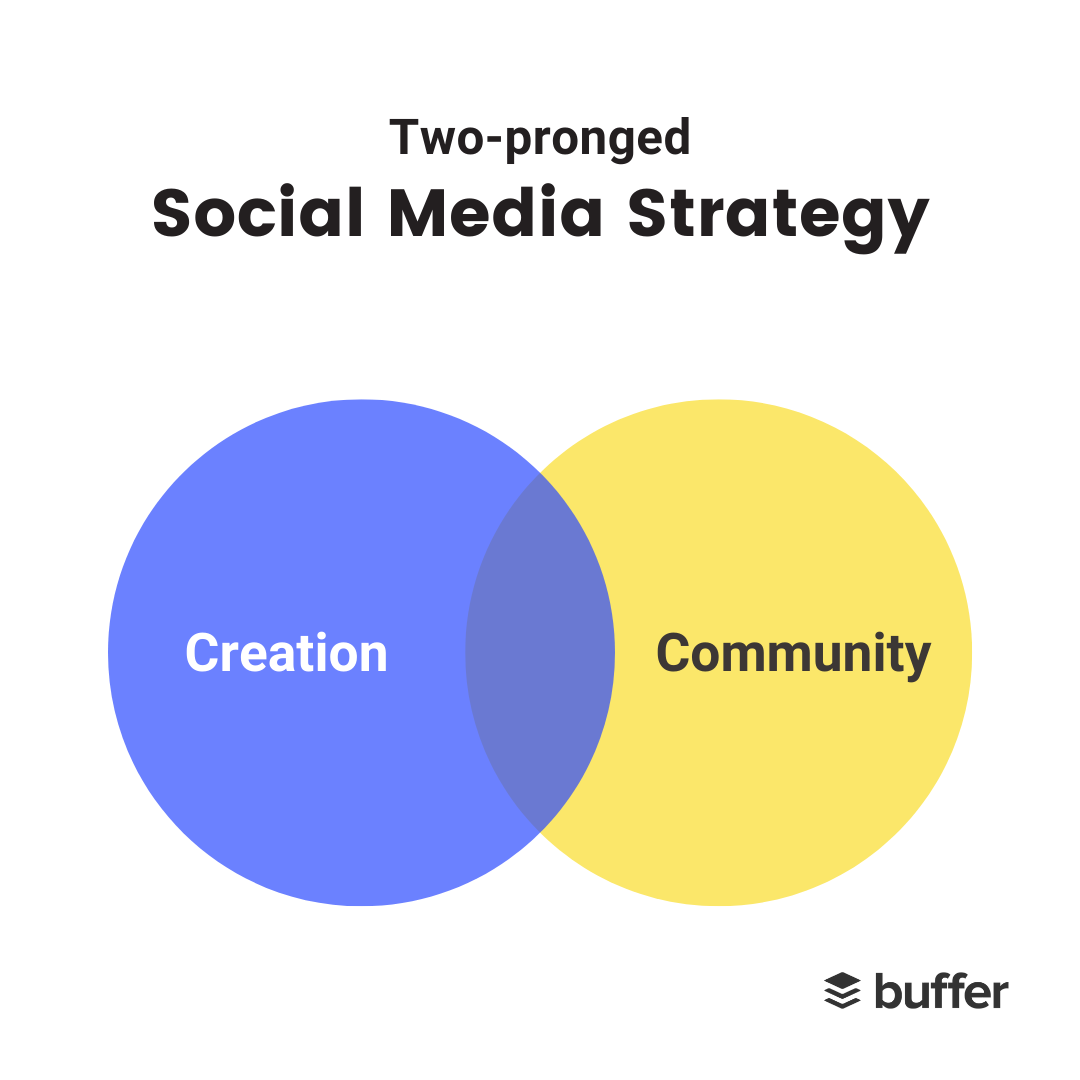
Perhaps the best way to talk about implementing a social media strategy is to show you a bit about how we do it here at Buffer. Here is our system for sharing on Twitter and Instagram
Buffer's social media strategy for Twitter
Our goal with social media is loyalty—with a twist. We’re interested in driving engagement and positive sentiment, two of the hallmarks of a loyalty strategy. We’ve also added a dash of sales to our mix. It’s not sales in the traditional sense; rather, we’re aiming to sell the value of the blog posts that we share. In this way, we’re also interested in boosting clicks back to the blog.
Our posting strategy
- We schedule 14 posts per weekday and 10 posts per Saturday/Sunday
- Our posting schedule is spread out throughout the day to connect with our global audience
- Our bread-and-butter post type: Visuals
- The majority of updates we share come from content in our blog archives
- We share one post each day from Buffer’s content suggestions
- We retweet a Buffer team member or Buffer community member once-a-day
- All new posts are shared multiple times that day and scheduled for further shares over the next two months
- All updates are in keeping with Buffer’s values of positivity and helpfulness
After posting updates according to the schedule, I like to borrow a tip from our repurposing efforts and come up with as many tweetable parts of the post as I can. These posts are added to a dummy Buffer account that I’ve set up as a kind of storage unit or backlog of useful tweets. When I’m in a pinch to fill our main queue, I can quickly and easily pull from this backlog and drag-and-drop into the Buffer Twitter profile.
As for sharing from our archives, we’ve found some helpful ways to do this.
- The first is a method created by our co-founder Leo. He’ll go to a random page on our blog (i.e., buffer.com/library/page/4) and share from each of the evergreen articles on that page.
- The other method I use relies on Buffer’s analytics. I’ll take any previous updates that earned a “Top Tweet” badge and drag them into my backlog, dummy account to easily share again later. (We’re big fans of reposting content here at Buffer.)
Our engagement strategy
- Reply to every mention of Buffer
- Engage the community with weekly questions
How would you spend your extra day off if you had a four day workweek?
— Buffer (@buffer) October 23, 2022
Replying to every mention is a very noble goal that I’ve personally tried to maintain on my own Twitter. It’s hard. Fortunately, we’ve got an army of Customer Advocates who invest time in responding to every Buffer mention out there.
3. How to measure a social media strategy
Find your key metrics. Set some goals. Revisit often.
To recap from above, depending on what focus you’ve taken with your social media strategy, you’ll likely have a few success metrics in mind that you’d like to track. Here’s the breakdown once more.
If you choose sales, you’ll want to track click rates, social e-commerce sales, and conversion rates.
If you choose loyalty, you’ll track engagement, sentiment, and influence.
If you choose awareness, you’ll track growth, engagement, shareability, likes, and subscribes.
At Buffer, we’ve taken to tracking our social metrics according to a neat method first proposed by Avinash Kaushik back in 2011. This theory of engagement breaks the metric into four parts that can track across all social networks:
- Conversation
- Amplification
- Applause
- Economic Value
Our friends at Moz introduced us to this tracking method, and they’ve shared how they measure these metrics and set goals for growing engagement and traffic back to their site. Here’s a peek at what their weekly reports look like.
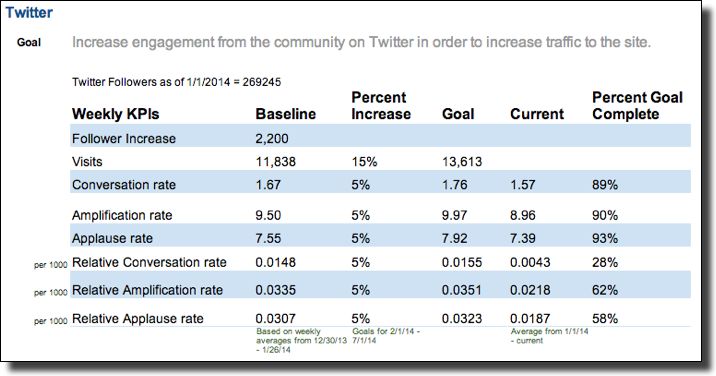
Another way to look for key metrics with your social media strategy is to approach it from a growth perspective. We’ve used the following grid to help guide our product growth here at Buffer, and in some cases, you can apply the same ideas to the metrics you pay attention to on social.
The key points to focus on in the grid below are “low conversion, high traffic” and “high conversion, low traffic.” For instance, tweets with high impressions and low clicks might be ripe for growth.
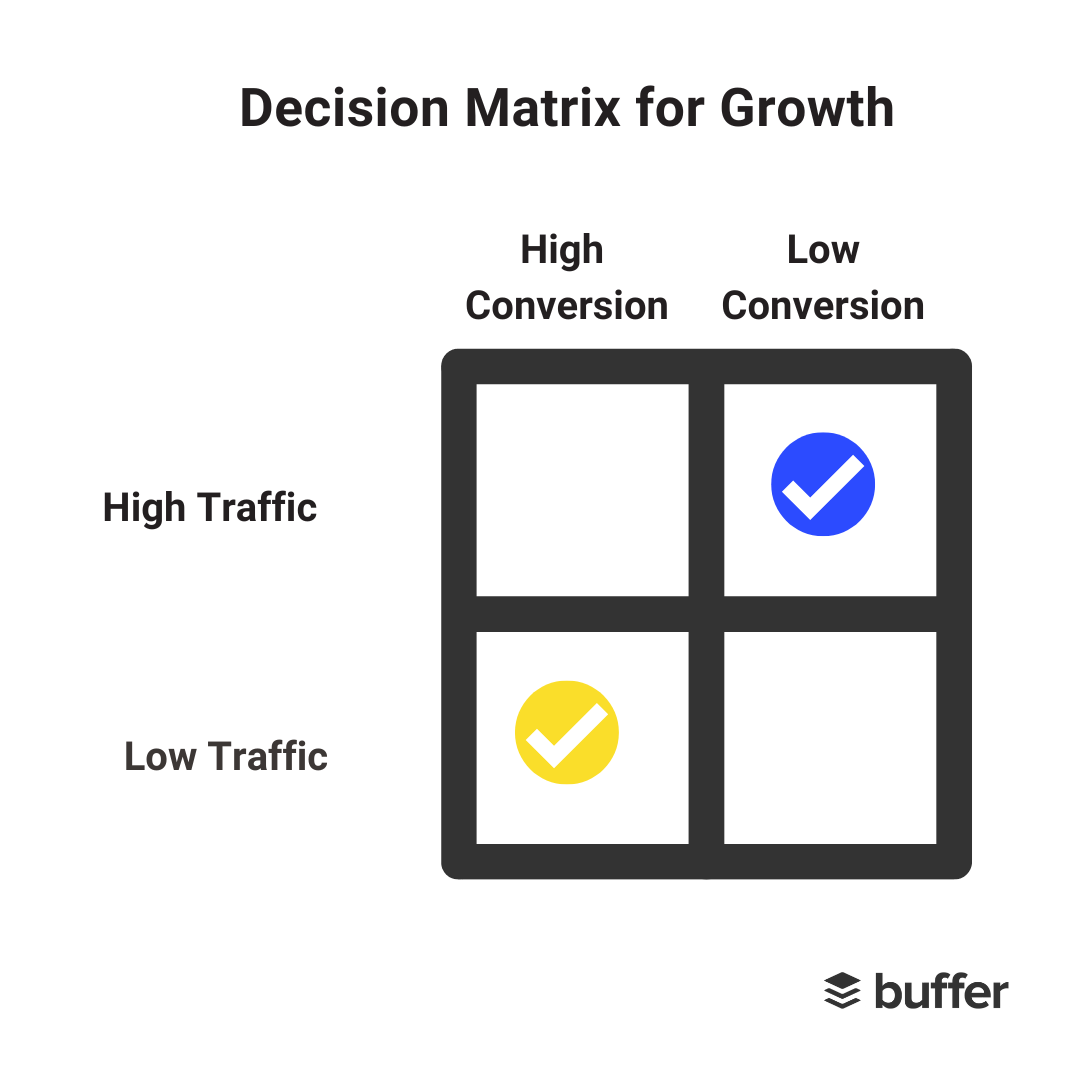
Over to you: How much time do you spend on social media each week?
The three parts of a social media strategy—planning, implementing and measuring—take time.
Fortunately, it can be a manageable amount of time if you have a plan in place and the right resources at your disposal. I’ve found that a weekly schedule that involves each strategic step helps to keep things on track and in place as we strive to meet our goals.
What’s been your experience with a social media strategy? How much time do you spend each week?
It’d be awesome to hear from you over on Twitter @buffer.






